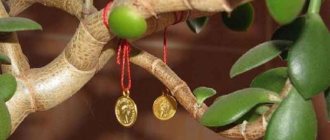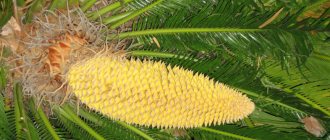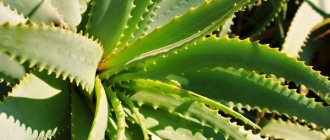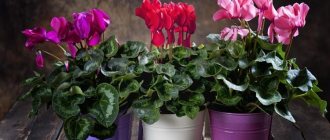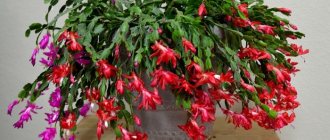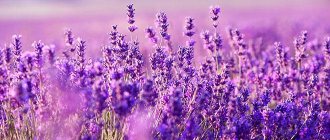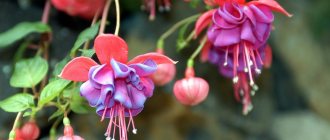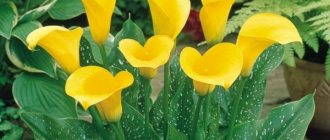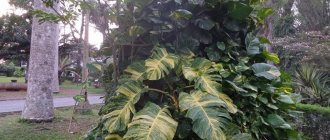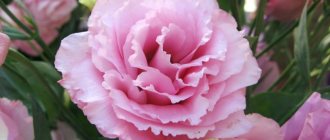Author: Elena N. https://floristics.info/ru/index.php?option=com_contact&view=contact&id=19 Category: Houseplants Published: March 25, 2014Last edits: January 11, 2021
- Adolph's Sedum / Sedum adolphii
Botanical description
Sedum (lat. Sedum) is a succulent from the Crassulaceae family of plants. The genus includes up to 600 plant species: succulents, one-, two- and perennial herbaceous plants, sometimes low shrubs. In nature, they are distributed in the northern hemisphere: temperate zones of Asia, Europe and North America. The name of the plant comes from the word “sit”, which characterizes the main property of the genus - to grow on almost any stone surface. Succulent species of sedum are usually grown indoors, so they require appropriate care: high temperature, moderate watering, sun, occasional feeding with special fertilizers. It is quite difficult to achieve flowering indoors: for this it is necessary to ensure a fairly low temperature in winter and high temperature in summer. Many species can be grown as hanging plants, since in nature sedums usually grow on stones and steep cliffs, hanging from them. Sedum is not only beautiful and good to cultivate, but also useful. The leaves are used in folk medicine to heal wounds and as a remedy for burns. Sedum extract is used as a biostimulant in the same cases in which aloe is used. House sedum is also known as sedum, fever grass and hernia grass.
General peeing
Sedum is an extensive genus. Its representatives can be low shrubs, but more often they are perennial herbaceous succulents. Some species are annual and biennial xerophytes. Often the stems of sedums are long, branching, intertwined and forming dense caps or hanging in long strands. But there are species that are practically devoid of stems and consist of a basal rosette of succulent leaves.
All sedums have whole fleshy leaves, most often without petioles and storing moisture reserves. They can be of various shapes - similar to ordinary leaves with smooth, jagged or wavy edges, short needles, elongated cylinders, balls or ovals, sometimes they look like arrows or blades. The color of the leaves varies from green in various shades to bluish, cream, purple, pink, and red. They are often two colors or change color depending on the light, temperature or time of year. The leaf size can be tiny, just a few millimeters, or quite large.
Sedums bloom in summer or autumn with small star-shaped flowers of white, pink, yellow or purple color. They are collected in inflorescences, most often spicate or corymbose. In most species, flowering is short-lived.
Briefly about cultivation
- Flowering: the plant is grown as an ornamental foliage plant.
- Lighting: bright sunlight.
- Temperature: spring and summer – 24-28 ºC, winter – 8-12 ºC.
- Watering: during the period of active growth - moderate, as soon as the substrate has dried to half its depth, and from November to February the substrate is moistened only so that it does not dry out completely.
- Humidity: any.
- Feeding: from March to September - once a month with a mineral complex for succulents and cacti.
- Dormant period: approximately from November to February.
- Transplantation: at any time of the year: young sedums - after a year, adults - after 3-4 years.
- Substrate: soil mixture for succulents or a substrate of sand, turf and leaf soil with the addition of fine expanded clay and a handful of charcoal.
- Reproduction: seeds and cuttings.
- Pests: root scale insects.
- Diseases: rot of the stem and roots, as well as exposure and stretching of the stem, wrinkling of leaves due to violation of maintenance conditions.
- Properties: Morgana sedum is a poisonous plant.
Read more about growing sedum below.
Reproduction methods
Propagation of sedum by cuttings
To propagate homemade sedum, the cutting method is used, and cuttings can be taken from leaf or stem. It is recommended to plant cuttings for rooting immediately after cutting. Stem cuttings are planted in a loose and moderately light soil mixture, for example, you can combine turf and leaf soil with sand (4:2:1). For planting, use a low and wide bowl; there is no need to cover the cuttings from above. They should give roots in about 2–3 weeks, and when another 15–20 days have passed, the plants can be planted in separate containers, which need to be filled with sand, turf and leaf soil (1:1:1). Sand is used to root leaf cuttings, and then they are planted in the same soil mixture as the stem cuttings. The room where the cuttings are located must be regularly ventilated.
Seed propagation
From seeds, such a flower can be grown in spring or autumn. To sow seeds, use bowls or low boxes. In order for seedlings to appear much faster, it is recommended to place the crops in a greenhouse. After the plants have formed the second or third true leaf plate, they must be planted in low pots, which are filled with substrate for seedlings (the composition is described above). The bush can bloom after 3 years or later, but only if it is properly cared for and provided with optimal conditions for growth.
Caring for sedum at home
Lighting
For good active growth of sedum at home, it is necessary to grow it in a place with bright light throughout the year. Direct sunlight will only benefit this plant, so the optimal place for growing sedum is a southern windowsill. Windows facing west and east are also suitable, but if the plant will not be shaded by curtains or leaves of other plants. Northern windows are least suitable, since a lack of bright lighting can cause the sedum shoots to stretch out and the plants to lose their decorative properties. It is likely that additional lighting with fluorescent lamps may be required in winter.
Temperature
Indoor sedum develops well over a wide range of temperatures. In summer, the temperature should still be high - about 24-28 °C above zero. In winter, home sedum feels good on cool window sills near cold glass; the optimal winter temperature is 8-12 °C. Keeping it warmer in winter leads to elongation of shoots and loss of decorativeness. The room needs to be ventilated from time to time.
Watering sedum
During active growth, the houseplant sedum should be watered moderately but regularly - the soil should dry out at least half between waterings. With the arrival of autumn, watering is reduced, and during the dormant period (November-February) they are watered only occasionally, so as not to let the earthen ball dry out. Use the rule “it’s better to underfill than overfill.”
- Why does chlorophytum dry out and turn yellow?
Spraying
This point is not important for sedum - it grows well both in dry air and in high humidity. Sedum leaves can be sprayed and wiped with a damp soft cloth to remove dust. No special increase in humidity is required.
Top dressing
From March to the end of summer, it is necessary to apply special fertilizers for cacti once a month, which are diluted in accordance with the instructions. From September until the end of the sedum's dormant period, no feeding is carried out.
Sedum transplant
The home flower sedum needs to be replanted every two years (young specimens), and older and more grown ones - once every three to four years. You need to replant carefully, because the leaves break off very easily, and a bare stem or “bald” places on it reduce the decorative qualities of the sedum. The plant practically does not tolerate stress during transplantation, so it can be replanted even during flowering, if there is an urgent need for it. I take a shallow pot, since the roots of the sedum are short. A drainage layer of expanded clay is poured onto the bottom of the pot to ensure the drainage of excess water after watering, and on top is a substrate made up of sand, turf and leaf soil in equal parts. It is advisable to add small bricks and small pieces of charcoal. You can use a ready-made substrate for succulents.
Propagation by cuttings
Sedum can be easily propagated indoors by cuttings - both stem and leaf. It is advisable to plant cuttings immediately after cutting. To plant stem cuttings, use a moderately light and porous substrate (you can use a mixture of 1 part sand, 2 parts leaf soil and 4 parts turf). There is no need to cover the bowl (it should be shallow) with cuttings. After 15-20 days, the cuttings will take root, and after another 2-3 weeks they can be transplanted into individual pots with a mixture of equal parts of leaf soil, turf soil and sand. Leaf cuttings of sedum are rooted in sand and then transplanted into the same substrate. In the room with cuttings you need to ensure a flow of fresh air.
Growing from seeds
Sedum is grown from seeds in autumn or spring. Seeds are sown in shallow boxes or bowls, which can then be placed in a greenhouse for faster seed germination. Picking is carried out in the phase of two or three true leaves, in shallow pots with soil for seedlings (see above). If the conditions are suitable and the care is correct, then the sedum may bloom, but this will not happen earlier than after 3 years.
Virulence
Sedum Morgana is poisonous and, if ingested, can lead to general weakness, vomiting and stomach upset. It is better not to make an infusion of sedum yourself.
- Lemon: growing from the seed
Possible difficulties
Problems from which the plant needs to be protected:
- Strong shadow . The leaves of the sedum become elongated and turn pale.
- Drought . Dried and wrinkled leaves.
- Stagnation of water and cold . Root rotting.
- Pests : caterpillars, weevils, aphids, thrips.
This unpretentious and beautiful plant is loved by gardeners and landscape designers for its resistance to disease and adverse weather conditions. Subject to proper care conditions, Kamchatka sedum will become an excellent assistant in creating beautiful and bright corners in the garden.
Diseases and pests
Exposure of the sedum stem. In sedum this can happen for several reasons. The main ones are lack of light (then the stems stretch and lose their decorative appearance) and mechanical damage, which causes the leaves to break off.
The roots of the sedum are rotting. The reason may be excessive watering when kept in cool conditions in winter. It is necessary to reduce watering, and the plant may have to be renewed by cuttings.
Sedum leaves dry out. Sedum is experiencing a lack of moisture. At the same time, the leaves may also wrinkle. It is impossible to let the earthen ball dry out - water the plant and the leaves will soon gain strength again.
The stems of the sedum are extended. In sedum, this happens if the plant does not have enough light (it is grown in the shade or on northern windows). It needs not just bright lighting, but also a certain amount of direct sunlight.
Sedum pests and diseases. Sedum may begin to rot if not properly cared for. It can also be affected by root scale insects.
Landing
Planting is done with a closed root system - the root is planted with the soil in which it was located in the nursery. Landing conditions:
- careful selection of material for planting - the cuttings should not have damage, limp leaves, or signs of disease;
- soil with sand and a small amount of compost or ash;
- good drainage;
- sunny place (slight shading is allowed).
Important! It is not recommended to plant a succulent under trees from which leaves fall abundantly; it is difficult for this plant to break through the dense foliage layer.
Kinds
Adolph's Sedum / Sedum adolphii
A representative of the genus is a branching shrub. The stem is initially straight, but over time it begins to bend, reaching just over 1 cm in thickness. The leaves are boat-shaped, wide, fleshy (about 5 mm thick), reach 4 cm in length and 1.5 cm in width, initially green in color (can be light green), but over time they take on a yellowish-pink tint. The leaf is slightly convex at the bottom, smooth and flat at the top. White flowers are collected in hemispherical inflorescences.
Weinberg's Sedum / Sedum weinbergii
This species is a succulent plant, grown as a hanging plant. The shoots are fleshy, recumbent, slightly erect. The leaves are glossy, with a waxy coating, elongated-ovate in shape, arranged alternately on the shoots, sessile, green-pinkish in color, slightly bluish. White flowers are collected in a corymbose inflorescence.
- Soil for plants
Gregg's Sedum / Sedum greggii
Also known as Sedum diversifolium. This herbaceous perennial is native to Mexico. The shoots are annual, at first erect and bare, over time creeping and slightly branching, short (up to 20 cm). The leaves are ovoid, very small (only up to 5 mm in length), green-grayish in color - these are the leaves on young shoots; on adult shoots the leaves are slightly longer (up to 12 mm in length), light green, convex. The flowering period occurs at the end of winter - end of spring, the flowers are yellow, growing only 2-4 pieces on a short peduncle.
Siebold's Sedum / Sedum sieboldii
This species, originally from Japan, is a herbaceous perennial that can often be found in indoor culture. Shoots up to 30 cm long, hanging. The leaves are sessile, light green in color, taking on a reddish tint towards the edges, and roundish in shape. Flowering period: early to mid-autumn. The flowers are pink. Quite hardy when grown indoors.
Sedum compactum / Sedum compactum
Another herbaceous perennial from Mexico. The leaves of this species have an elongated ovoid shape, are arranged imbricately and tightly to each other, green-grayish in color, and small. The flowering period is early to mid-summer; 2-3 white flowers with a pleasant smell appear on the peduncle.
Red Sedum / Sedum rubrotinctum
This species is a low plant. The shoots are creeping, but over time they rise slightly. The leaves are dark green with a reddish tip, round in shape, growing in apical rosettes. The flowers are bright red.
Sedum lineare / Sedum lineare
A herbaceous perennial native to Japan and China. The shoots are creeping, branch well and densely, and take root easily. The leaves are small, arranged in whorls of three or four, flat on the upper side, light green in color, linear in shape (up to 0.5 cm wide, and up to 1.5 cm long). Usually grown as a hanging plant, the flowering period occurs at the end of spring - beginning of autumn, blooms with yellow flowers collected in umbrella-shaped inflorescences.
Morgan's Sedum / Sedum morganianum
A herbaceous perennial native to Mexico. The shoots are long (up to 1 m in length) and densely covered with leaves. The leaves are light green, elongated oval in shape (up to 20 mm long, up to 5 mm wide), voluminous, the upper side of the leaf is straight. The species is grown as an ampelous plant, which can even bloom well. The flowers are red-pink in color, collected in umbrella-shaped inflorescences of 10-15 pieces.
Sedum potosinum
This species is a succulent, a perennial plant. Young shoots of this species are creeping and rise with age. The leaves are linear in shape, rounded at the apex, arranged alternately on the shoot, sessile, with a light green leaf blade with a white sheen and a pinkish tip. The plant quickly grows shoots, so it needs regular pruning. Blooms with white flowers.
Sedum Stahl / Sedum stahlii
Large herbaceous perennial subshrub from Mexico. It can reach a height of 20 m (in nature). The stem has almost no branches and is straight. The shoots creep and branch weakly. The leaves are arranged oppositely, small, about 1 cm long, 2-4 mm smaller in width, ovoid in shape, thick, slightly pubescent, red-brown in color. The flowers are collected in a paniculate inflorescence at the top of a branched peduncle. The flowering period occurs at the end of summer - beginning of autumn, the flowers are yellow. This species is popular in indoor culture.
Creeping sedum / Sedum humifusum
Soddy low representatives of the genus from Mexico. The leaves of this species are ovoid in shape, the edges are covered with small hairs, and are green in color, becoming reddish over time. Flowering period is from mid-spring to early summer. The flowers are yellow and grow one at a time.
Sedum pachyphyllum
Subshrubs from Mexico, grow up to 30 cm in height. The leaves are dense, bluish-gray, the tip of the leaf takes on a red tint, has a club-shaped shape, reaches a length of 4 cm, the tip is obtuse. The flowering period occurs in mid-spring, the flowers are yellow-green or pure yellow, the inflorescence is umbellate.
Trelisa's Sedum / Sedum treleasii
A herbaceous perennial native to southern North America. Stems are dark brown, straight, woody. The leaves are glossy, light green, ovoid, can be slightly elongated, up to 25 mm in length and up to 10 mm in thickness. Light yellow flowers are collected in hemispherical inflorescences.
Useful video
How to properly prune a plant when it begins to stretch, watch the video:
Original compositions from sedum can be created both in personal plots and in residential or office premises. With timely and proper care, the plant will delight you with its beauty for many years.
READ ABOUT OTHER SUCCULENTS: GASTERIA, COTYLEDON, GRASSWORTH, LITHOPS, REJUVEN, a href=”https://botanicoved.com/komnatnye/sukkulenty/raznovidnosti-sukkulenty/pahifitum.html” rel=”noopener” target=”_blank”> PACHYPHYTUUM, PORTULACARIA, SEDEVERIA, STAPELIA, HAWORTIA, EONIUM, ECHEVERIA.
